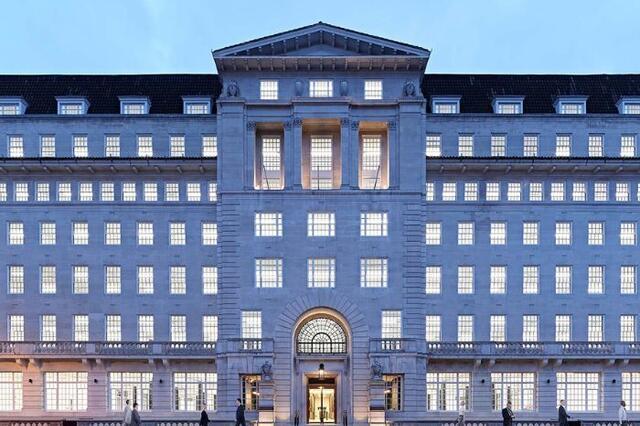Brookfield Properties upgrades 1930s building to 21st century standards
14 February 2023Brookfield Properties upgrades 1930s building to 21st century standards
14 February 2023At The Gilbert in London, Brookfield Properties has brought energy performance up to modern standards while retaining 90% of the original structure. Upgrades include air source heat pumps, improved air tightness and extensive roof terraces for wellbeing and biodiversity. This has extended the lifespan of the 1930s building, preserving architectural heritage and meeting the needs of today’s occupiers. The Gilbert is the first Brookfield Properties building to achieve net zero in construction, in line with the UK Green Building Council framework.
Key Facts
- 75% lower embodied carbon than LETI’s 2020 benchmark – at only 147kg CO2e/m2 (A1-A5)
- Predicted operational energy performance ahead of the UKGBC 2025 Paris Proof target
- 10,500 sq ft of outdoor spaces, including a courtyard and seven terraces with views
Situation
Brookfield Properties is a global developer and operator of real estate assets. It is committed to reaching net zero emissions by 2050 or sooner.
The Gilbert at Finsbury Square in London was originally designed as a private members club by Sir Giles Gilbert Scott in the 1930s. In redeveloping the building, Brookfield Properties prioritised retaining as much of the structure as possible, to preserve architectural heritage and character, reduce embodied carbon and achieve construction and cost efficiencies. The substantial refurbishment has upgraded the building to meet the needs of modern occupiers and added new space through roof extensions. The project team included architects Stiff + Trevillion, engineers Hilson Moran and construction contractor Mace.
Actions
Reducing embodied carbon
Hilson Moran carried out a whole life carbon study to measure and reduce emissions from the development. This led to 90% of the original structure being retained, including the heritage façade and architectural features. The team refurbished and resealed the original windows, which are a distinctive feature of the building. Ceilings are also left exposed, revealing architectural characteristics and reducing embodied carbon. Carbon Intelligence completed a third-party audit of the whole lifecycle carbon assessment, in line with the UKGBC Net Zero Carbon framework.
Operational energy improvements
High efficiency air source heat pumps provide almost all heating, with a backup gas boiler for perimeter areas on peak cold days. Opening windows provide free cooling for energy efficiency and wellbeing. All mechanical and electrical plant has been replaced with the latest high efficiency options, including zoned controls for flexibility. New build elements are all well insulated and deliver high energy performance. Brookfield Properties will keep a close eye on operational performance, to ensure that The Gilbert is achieving its design potential.
Wellbeing
The Gilbert provides 10,500 sq ft of outdoor spaces for occupiers to enjoy, promoting wellbeing and biodiversity. These include a courtyard at ground level and seven terraces with views. Period windows flood natural daylight across each floor, along with two lightwells. There are 121 bike spaces, 123 lockers and 17 showers to encourage active lifestyles and sustainable commutes. Located a few minutes’ walk from both Moorgate and Liverpool Street stations, The Gilbert offers excellent public transport connections.
Financial
The substantial reductions in embodied carbon reduced the cost of achieving net zero, making it feasible for Brookfield Properties to offset residual embodied emissions through the Fresh Breeze afforestation project in Mexico. A long-term project registered by the Verified Carbon Standard (VCS), with established forest plantations, as an afforestation, reforestation and revegetation project. This enables immediate procurement and retirement of high-value carbon credits, meeting the requirements of the UKGBC definition of Net Zero Carbon in Construction.
Benefits
- Aligning with the UKGBC Net Zero Carbon framework.
- Supporting the climate and sustainability goals of Brookfield Properties and occupiers.
- Extending the lifespan of the 1930s building and preserving architectural heritage.
- Reducing operational energy costs and improving wellbeing for occupiers.
- Contributing to the growing industry evidence base in support of refurbishment over new build.
Results included:
- 75% lower embodied carbon than LETI’s 2020 benchmark of 600kg CO2/m2, at 147kg CO2/m2 for RIBA stages A1-A5, saving 9,500 tonnes of carbon. This is 58% less than LETI’s 2030 design target of 350kg CO2/m2.
- Potential to outperform modern energy efficiency standards with a predicted 87.3 kWhe/m2 for base building energy NLA. This is 3% less than the UKGBC 2020-2025 interim target. The building achieved Energy Performance Certificate B.
- Platinum ActiveScore certification for active travel facilities and services.
Challenges and Achievements
WHOLE LIFE CARBON
How do you balance embodied and operational emissions?
At The Gilbert, the decision to retain the façade dramatically reduced embodied carbon. It would be possible to refurbish the building seven times before reaching the same embodied carbon as one standard new build. However, retaining the façade also impacted on operational emissions, as a new, insulated façade and glazing would have reduced energy demand and avoided the need for a backup gas boiler to warm the perimeter. This would have made The Gilbert fully electric, with air source pumps providing all heating, and all electricity on renewable tariffs. In some countries, such as Germany, occupiers are very aware of whole life carbon and take this into account when leasing space. In the UK, the focus for occupiers is primarily on operational emissions, as their performance is judged on their energy efficiency. A shift is needed to allow occupiers to benefit from the wider whole life carbon saving of taking space in a retained building, which is much less carbon-intensive than new build.
*Please note that the information on this page was supplied by the BBP Member and the BBP assumes no responsibility or liability for any errors or omissions in the content

